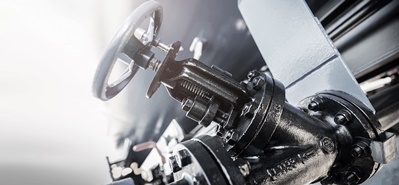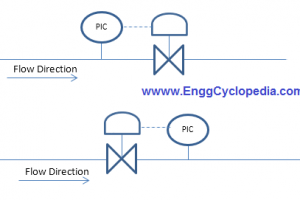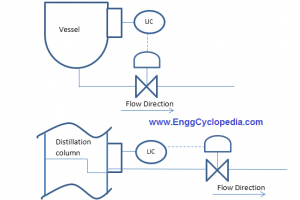Control valves are elements used in process control loops to adjust process variables such as flow, liquid levels, pressure, temperature etc. Control valves maintain the desired operating conditions such as flow rate, level, temperature and pressure required for the efficient operation of the process plant. Not all type of valves can be used as control valves. Following is the guide for use of different types of control valves based on application as well as services and caution where not to use it.
Table of content:
1. Ball valve
2. Gate valve
3. Butterfly valve
4. Plug valve
5. Diaphragm valve
6. Globe valve
7. Motor operated valve
8. Self actuated pressure control valve
9. Joule thomson valve
10. Types of manual valves

Ball valve
This type of control valves use a spherical shaped closure member with a cylindrical bore through the member for passage of flow. This spherical closure member has to be rotated by 90 degrees to bring the valve from fully closed position to fully open position. This type gets the name from the shape of the closure member. If the diameter of the cylindrical bore is same as that of the connecting pipe, the valve is known as full bore valve. If this diameter is less than that of the connecting pipe, the valve is known venturi style valve. These valves rotary stem motion.
- Ball valve has advantage of lower pressure drop when full open, this also makes it suitable where lower pressure drop are required.
- Ball valves are light weight and compact.
- Ball valves are suitable for use for flow reversal and direction change is required.
- Ball valves are not recommended for high pressure drop service where choke flow or cavitation is likely.
Gate valve
Gate valves use linear type of stem motion for opening and closing of valve. These valves use discs as closure member, as can be seen in the following figure. The faces of this disc can be either parallel or the disc can be wedge shaped.
- Usually, gate valves are not preferred choice of control valves but it can be used services where use of ball valve or butterfly valve is not recommended and precise control is not required.
- Gate valve has advantage of lower pressure drop; this also makes it suitable for lower pressure drop applications.
- Gate valves are suitable for liquid with solid content.
- Gate valves shall not be used in application of frequent opening and closing is required.


Butterfly valve
Butterfly valves are known for their compact size and low initial costs, which is primarily due to the small wafer and body size of these valves and the simplicity of this design. These type of control valves belongs to the rotary stem motion type of valves.
- Use of butterfly valve as control valve is recommended where service is clean and no solids or crystallization is expected like clean liquid or gaseous service.
- Butterfly valves give lower pressure drop among all control valves as well as the lower price makes it preferred choice compared to other control valves for sizes 4 inch (100 mm) and above.
- Typical examples of butterfly valve as control valve are cooling water distribution, gas distribution, etc.
There are few limitations of butterfly valve.
- Butterfly valve has uneven dynamics and flow control is not proper at partial opening conditions.
- Solid particles get accumulated and closing might be impaired due to this.
- Due to its nature it introduces large turbulence in the downstream system. It is prone to vibrations, leaks and damage
- Butterfly valve also has limitations in terms of closing and opening action, sudden closing might lead water hammer kind of situation and for opening it needs larger torque to open and in some applications it becomes quite difficult.
Plug valve
Plug valves are similar to ball valve but shape of plug makes it different and that allows it to handle fluid with solids. It consists of a cylindrical or conical plug that can be rotated inside the valve body to open or close the flow passage. The plug has a through hole, also known as a port, which aligns with the pipeline when the valve is open, allowing the fluid to flow through. When the valve is closed, the plug is rotated to block the port, cutting off the flow.
With its ability to handle the solids in the fluid along with the numerous ports like 3 or even 4 port makes it good choice for use in various applications. These valves are also suitable for on/off operations only. Plug valves are relatively costlier and it is not recommended for throttling action.
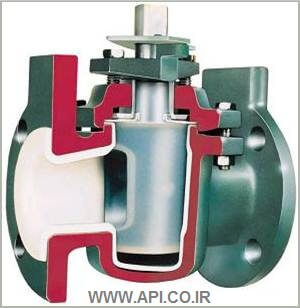

Diaphragm valve
A diaphragm valve is a type of valve that uses a flexible diaphragm to control the flow of fluids. The diaphragm is a thin, flexible membrane that separates the valve body into two chambers. By deforming the diaphragm, the flow passage can be opened or closed, allowing or blocking the flow of fluid through the valve.
Diaphragm valves are well suited for the abrasive services as it does not have direct contact of fluid it is handling. Diaphragm material can be selected based on service. Diaphragm valves have good control and with proper sealing these valves can be used for throttling service without any major issues. Typical applications where Diaphragm valves can be used are slurry service, sanitary services as well as microbiological liquid. In terms of limitations, the diaphragm valves are expensive.
Globe valve
Globe valves are most commonly used liner stem motion type control valves. The flow control for this type of valves is achieved by motion of a plug as shown in the figure. A globe valve consists of a spherical body with an inlet and outlet port, a movable disk or plug, and a stationary ring seat. The disk or plug is connected to a stem that is operated manually, electrically, or pneumatically to control the position of the disk in relation to the seat.
- They are very good in terms of control.
- Globe valve can be used for wide range.
- Most of the industrial applications in process industry uses globe valve as control valves.
- With proper trim arrangements these valves can be used for multiphase services as well as flashing applications where other control valves are not recommended.
- In terms of limitations, in globe valve mechanism the fluid changes its direction and passes through the opening which is controlled by disc. This mechanism will lead to higher pressure drop in the control valve. The size of valve also becomes limitations for bigger sizes.


Motor operated valve
A motor-operated valve (MOV) is a type of valve that uses an electric motor to open or close the valve mechanism. It is commonly used in industrial applications, particularly in process plants, power plants, and oil and gas facilities. The motor provides the necessary torque to actuate the valve, allowing for precise control over the flow of fluids or gases.
Self actuated pressure control valve
Self actuated pressure control valves do not depend on any external signal for pressure control. As the name suggests, pressure in the process line itself is used as an actuating signal to open or close the pressure control valve. Check this detailed post on self actuated pressure control valve.
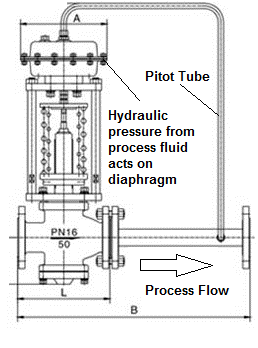
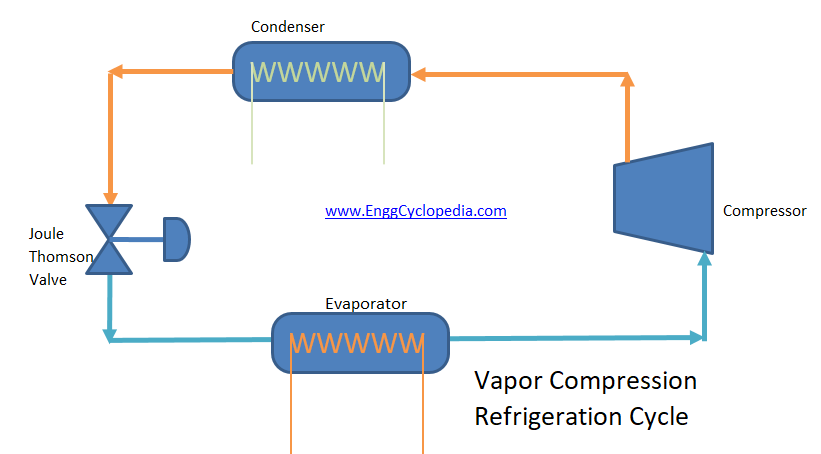
Joule thomson valve
A Joule Thomson valve also commonly known as a JT Valve is a flow control valve which capitalized on the 'Joule Thomson effect' to cool down a compressed gas by throttling its flow and causing rapid expansion. Joule Thomson effect suggests that rapid expansion of a real gas will cause it to rapidly cool down as well.
The Joule-Thomson effect refers to the change in temperature experienced by a gas when it undergoes a throttling process, such as passing through a restricted flow area. When a compressed gas expands rapidly through a valve or orifice, it experiences a drop in pressure and, as a result, a change in temperature. Therefore JT valves are commonly used in the vapor compression refrigeration cycle.
Manual valve types and usage
Manual valves are mechanical devices used to control the flow of fluids (liquids, gases, or slurries) through a pipe or conduit. They are operated manually by a person, typically by turning a handle or lever. There are various types of manual valves, each with its own design and specific applications. Check the given post to study commonly used manual valves. Explore their structure, features, application, materials in that post.
